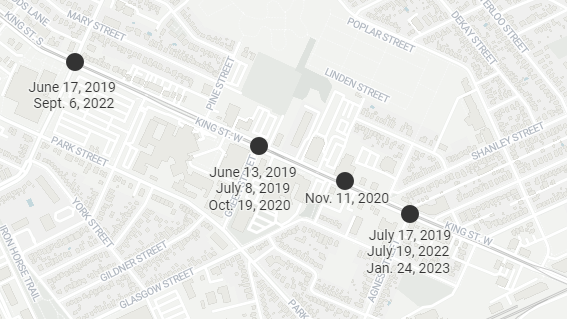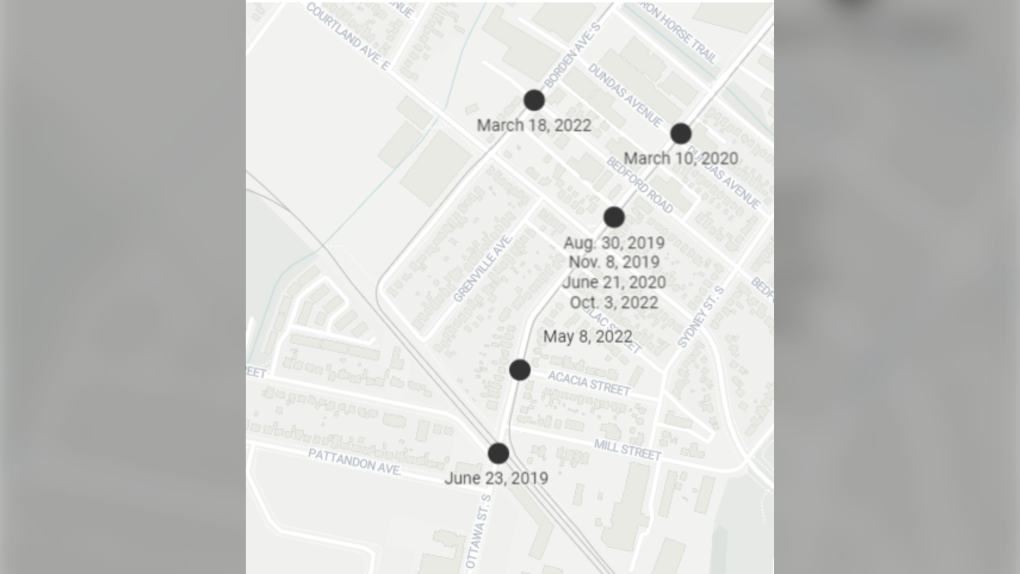At least 24 crashes involving ION LRT since inception in 2019
Since Waterloo Region’s LRT started operating in the summer of 2019 there have been a number of crashes involving ION trains.
The crashes have typically involved vehicles, but there have also been run-ins with cyclists and one crash where a pedestrian was fatally struck.
The first time a person was hurt was just months after the LRT trains began operating.
 This section of King Street between Agnes Street and Green Street in Kitchener has seen at least nine crashes involving LRT trains in the last four years. (Daniel Caudle/Datawrapper)
This section of King Street between Agnes Street and Green Street in Kitchener has seen at least nine crashes involving LRT trains in the last four years. (Daniel Caudle/Datawrapper)
On Nov. 8, 2019 a cyclist was sent to hospital after turning in front of an ION train on Courtland Avenue East near Ottawa Street South.
That cyclist was later charged with careless driving.
A couple of months later, on the morning of Jan. 4, 2020, a southbound train struck 39-year-old Jason Rastel on Columbia Street West near Phillip Street. He was pronounced dead at the scene.
It was the first and only fatal LRT train crash since the ION launched.
Some other notable crashes include when a cement truck smashed into the side of the ION on King Street East Near Agnes Street last July.
CTV News Kitchener has reported on a total of 24 crashes between May 2019 and March 2023.
 This section in south Kitchener comprising of Ottawa Street South near Courtland Avenue East has seen several crashes since the LRT began operating. (Daniel Caudle/Datawrapper)
This section in south Kitchener comprising of Ottawa Street South near Courtland Avenue East has seen several crashes since the LRT began operating. (Daniel Caudle/Datawrapper)
Of those, the intersections with the highest number of incidents include:
- Seven on King Street between Green And Agnes
- Two at King Street and Union
- Four at Ottawa and Courtland
One of the crashes happened in May of 2019 before operations officially began - at that point the trains were in testing.
The list provided only includes only the crashes CTV News Kitchener has reported on.
CTVNews.ca Top Stories

LIVE NOW Budget 2024 prioritizes housing while taxing highest earners, deficit projected at $39.8B
In an effort to level the playing field for young people, in the 2024 federal budget, the government is targeting Canada's highest earners with new taxes in order to help offset billions in new spending to enhance the country's housing supply and social supports.
BREAKING Feds cutting 5,000 public service jobs, looking to turn underused buildings into housing
Five thousand public service jobs will be cut over the next four years, while underused federal office buildings, Canada Post properties and the National Defence Medical Centre in Ottawa could be turned into new housing units, as the federal government looks to find billions of dollars in savings and boost the country's housing portfolio.
Some of the winners and losers in the 2024 federal budget
With a variety of fiscal and policy measures announced in the federal budget, winners include small businesses and fintech companies while losers include the tobacco industry and Canadian pension funds.
From housing initiatives to a disability benefit, how the federal budget impacts you
From plans to boost new housing stock, encourage small businesses, and increase taxes on Canada’s top-earners, CTVNews.ca has sifted through the 416-page budget to find out what will make the biggest difference to your pocketbook.
Liberals aim to hit the brakes on car theft with new criminal offences
The Liberals are proposing new charges for the use of violence while stealing a vehicle and for links to organized crime, as well as laundering money for the benefit of a criminal organization.
Feds offer $5B in Indigenous loan guarantees, fall $420B short on infrastructure asks
The federal government is providing up to $5 billion in loan guarantees to help Indigenous communities invest in natural resource and energy products. But when it comes to a promise to close what advocates say is a sprawling Indigenous infrastructure gap, Ottawa is short more than $420 billion.
BREAKING Police to announce arrests in Toronto Pearson airport gold heist
Police say that arrests have been made in connection with a $20-million gold heist at Toronto Pearson International Airport one year ago.
Proposed class-action lawsuit against Shoppers Drug Mart alleges 'unsafe and unethical corporate practices'
Shoppers Drug Mart is facing a proposed class-action lawsuit by current and former franchise owners at the retail chain who allege parent company Loblaw engaged in corporate practices that placed them in an “irredeemable conflict of interest” and put patient care at risk.
Lululemon unveils first summer kit for Canada's Olympic and Paralympic teams
Lululemon says it is combining function and fashion in its first-ever summer kit for Canada's Olympians and Paralympians.
































